The Sharada Script:
Origin and Development
- B. K. Kaul Deambi
Among the Western Himalayan scripts the Sharada
alphabet has a place of pride. Evolved from north western Brahmi a millinium ago
in the 9th century A.D. it remained in popular use for several centuries in an
extensive area of Western Himalayas including North Western Frontier Province,
Dardistan, Kashmir, Jammu, Ladakh and Himachal Pradesh. The epigraphic and
literary records written in this script, that have been found in these regions,
have thrown light on many facets of the history and culture of the areas of
their provenance 1. The inscriptions of the famous Hindu Shahi Dynasty of Kabul
and Ohind and of the Shahi Dynasty of Gilgit, bulk of extant epigraphic and
literary records of Kashmir produced from 9th century onwards, the inscriptions
including the copper plate charters, fountain stone inscriptions and the temple
inscriptions of the erstwhile Western Himalayan States of Chamba and Kangra, and
the legends of the coins of the Shahis, the rulers of Kashmir and Mahmud of
Ghazni are written in this script. This fact considerably enhances the value of
the study of this important regional alphabet for the critical study and
analysis of the valuable record, written in this script and preserved in several
celebrated museums and libraries of the world. Like the Brahmi and the Kharoshti
in the ancient period, the Sharada script in the early medieval period formed a
vital link in the chain of communication of ideas, knowledge, and culture among
the states comprised in the Western Hirnalayan region. Unfortunately the
knowledge of this important script is fast disappearing threatening thereby the
loss of this rich and proud heritage of Western Himalayas to posterity for ever.
As in this part of the country, the Brahmi (the
well known national script of ancient India) continued to be the popular mode of
writing in Western Himalayan region throughout the ancient period. This is
indicated by several surviving epigraphic and literary records discovered from
different parts of the region (see infra). During the long period of its
use the Brahmi alphabet passed through several stages of development and its
characters assumed different forms in different areas of its use and by about
7th and the succeeding centuries the original appellation gave way to new
regional denominations like Bangala, Oriya, Marathi, Tarnil, Telegu and Nagari.
These scripts though direct descendants of the Brahmi showed several
characteristic peculiarities so as to justify new nomenclatures.
The Sharada was one such denomination. It evolved
as a direct descendant of the Brahmi around 9th century A.D. and covered a vast
region extending from Afghanistan in the north-west to Delhi in the south-east.
Though its characters showed remarkable resemblance with earlier Brahmi
characters in use in the region, they exhibited several peculiar developments
positive enough to justify a new appellation.
The earliest known records in which the Sharada
characters appear for the first tirne are the coins of the Utpala dynasty of
Kashmir (9th century)2 and a brief record incised on the fragment of a broken
jar discovered from the precincts of the Avantiswami temple and containing the
name of Avantivarma (855-883 A.D.) the founder of the temple3. Of about the same
date is the Sarahan Prashasti of queen Somaprakha, spouse of Satyaki, a ruling
chieftain of Sarahan opposile Saho in ancient Chamba (Himachal Pradesh)4. Among
the other records of slightly later date mention may be made of the Dewai (NWFP)
inscription of the Shahi king Bhimadeva (lOth century)5, inscriptions of the
reign of queen Didda (A.D. 980/1-1003)6 in Lahore Museum and S.P.S.Museum,
Srinagar, the Brahmor and Sungal (District Chamba, Himachal Pradesh) copper
plate inscriptions of king Yugakaravarman and his son Vidagdhadeva7, Barikot and
Hund (NWFP) inscriptions from Hund including that of the queen Kameshwari Devi.9
Sharada remained an alphabet par excellence of
Kashmir till the present century and owed its name to the valley which from
ancient times bore the alternative name of Sharada-desha and Skarada-mandala
owing to its tutelary deity Sharada, the Goddess of Learning. The other name of
the alphabet was Siddha-matrika by which name the script is referred to
by Alberuni10. This name is due to the fact that the alphabet starts with the
benediction Om Swasti Siddham. The alphabet continued to be used in
Himachal Pradesh and Punjab up to the 13th century when it was replaced by its
descendant, the Devashesha which in turn gave rise to the modern alphabets of
Gurmukhi and Takari. In Kashmir, however, its use continues to this day though
it is confined to the older generation of the priestly class.
Considering the extent of the region over which
the Sharada alphabet remained in use for a long time, the number of Sharada
epigraphic records discovered so far is by no means very large. Hardly one
hundred and odd inscriptions have been discovered so far, 13 in north Western
Pakistan, 34 in Kashmir, 6 in Jammu, 5 in Ladakh, 39 in Himachal Pradesh and one
in Delhi.
On the basis of the Sharada characters used in
these records three successive stages of development of the Sharada alphabet can
easily be discovered. The earliest phase is represented by the inscriptions and
coins of 9th-10th centuries, the second by those of the 11th-13th centuries and
the third and final by the epigraphic and literary records of the 14th and
subsequent centuries.
While the use of the Sharada alphabet in the
inscriptions dates from the 8th century A.D. its use in the manuscripts,
however, is not known earlier than the 12th century when we find it first used
in a manuscript discovered from the village Bakhshali in the Peshawar district
of Pakistan11. The manuscript, the title of which is lost, contains an important
work on Mathematics, but bears no date. On palacographic grounds, however, it
can be assigned to the 12th century. Next in date is an old birch bark
manuscript of Munimata- mani-mala which is the earliest known Sharada
manuscript discovered so far in Kashmir, assignable on palacographich ground to
the 14th century 12. The other early known manuscripts are the birch bark
manuscript of Shakuntala 13, birch bark manuscript of the Adi and Sabha
Parvan of the Mahabharata and the birch bark manuscript of Kathasarit- sagara,15
all assignable to 16th century.
ORIGIN [16]
I. The Brahmi alphabet of north-western India of the 3rd
century B.C., generally called the Mauryan alphabet, is represented by:
(1) The Kalsi Rock Edicts 17
(2) The Delhi-Topra pillar-edicts 18
(3) The Pathyar (District Kangra, Himachal Pradesh) rock
inscription 19.
II. The Brahmi alphabet of north-western India of the 2nd
century B.C. to the beginning of the Christian era, usually called the post-Mauryan
alphabet, is represented among others by the following records:
1. The coins of the Indo-Grecian Kings Agathocles the
Pantaleon20
2. The inscriptions of the ksatrapa Sodasa21
3. The Kanhiar (Dist. Kangra, H.P.) rock inscription22
4. The Bathtsal (Jammu) cave inscription23.
The post Mauryan alphabet displays two remarkable
developments.
a. The shortening and the equalisation of the upper
vertical lines,
b. the development of top marks represented by serifs,
nail heads, or triangular wedges.
III. The inscriptions of the Kusana kings-Kaniska, Huviska
and Vasudeva24, discovered form Mathura and its vicinity, illustrate the next
step in the develcpment of the Brahmi of north-western India.
IV. Further development of our alphabet is
illustrated by the following records of the 4th and 5th centuries A.D. which
represent the western variety of the northern Indian alphabet of the 4th and 5th
centuries A.D., generally called the Gupta alphabet:
1. The Abbotabad inscription of the time of Kadambesvara
dasa (Gupta) year 25 = A.D. 344 [25]
2. The Mathura inscription of Chandragupta II, G.E. 61 =
A.D. 380 [26]
3. The Mathura stone inscription of Chandragupta II [27]
4. The Shorkot inscription of the year 83 [28]
5. The Tussam (Dist. Hissar) rock inscription29
6. The Lahore copper seal inscription of the Maharaj
Mahesvaranaga30 and
7. The Bower manuscript31.
In the following records of the 6th and the 7th centuries
A.D., discovered in northwestern India, we find further development of the forms
of the Western Gupta alphabet leading to those of the Sharada in the 9th
century.
1. Kura inscription of Toramana32
2. The Nirmand plate of Mahasamanta Maharaja
Samudrasena33
3. The Sonepat Seal of Harsavardhana34
4. The Hatun rock inscription of Patoladeva35
5. The Gilgit manuscripts36.
VI. We shall now discuss in detail the forms of the early
Sharada characters as represented by the early records referred to above:
1. The initial a and a retain the same form as noticed
in the Bower Manuscripts and the records of the 6th-8th centuries.
2. In i however, we notice a significant development.
The earlier curve below the two dots in turned round and drawn towards the
left.
3. i had the same form as in the Bower manuscripts. 4. u
and u also retain the same forms and do not display any significant change.
5. In e the development is marked by the addition of a
wedge at the left top end.
6. o shows no change.
7. k also retains the forms of 6th and 7th centuries.
8. In kh the earlier downward stroke has been converted
into a well formed vertical in the copper- plate inscriptions.
9. g shows a flat top and a wedge, a small triangle, a
serif or a small upward stroke at the lower end of the left vertical.
10. gh and n do not present anything remarkable except n
shows generally a serif at the right top end.
11. c occurs both in the rounded and quadrangular forms.
12. j shows a serif or a wedge at the right top end.
13. jha retains its earlier form.
14. h shows well developed top bar.
15. t. occurs both in the archaic rounded form and the
later developed form with a flat top.
16. Buhler mentions d as one of the Sharada letters
which exhibits a peculiar development. He describes it as showing a loop in
the middle instead of an acute angle and a wedge at the lower end. However, it
may be pointed out here that the loop which occurs frequently in the later
Sharada especially in the manuscripts is conspicuously absent in our early
Sharada records. Moreover in place of the wedge at the lower end we sometimes
find a fork as in the Brahmor copperplate and sometimes a small triangle as in
the Sungal grant.
17. The cerebral nasal occurs both in the earlier form
with a base stroke as, e.g., in the Sarahan prasasti and in the later form
with the base suppressed and the two curves united and supported on the right
by a small upward stroke. Occasionally we meet with a further cleveloped form
as, e.g., in the Brahmor plate where the letter is provided with a down stroke
attached to its left and slanting towards the right.
18. t retains the same form as in the 6th and 7th
centuries.
19. th mostly retains its earlier rounded form. In one
instance in the Srinagar inscription of queen Didda, we find the letter with a
flat top.
20. d does not present anything remarkable.
21. dh occurs in its ancient crescent form and in one
inscription (Srinagar) the letter shows a quadrangular shape evidently caused
by the flattening of the top and the bottom.
22. The dental nasal retains the form of the 6th and 7th
centuries.
23. p, ph and b do not call for any special remark.
24. bh occurs in two forms either with an inverted wedge
or with an open triangle. The triangle sometimes more open and less defined
and the letter looks like h.
25. The letter m generally retains its earlier shape.
Sometimes, however, the right hand vertical protrudes downwards and there
appears a knob or a small triangle on the left.
26. The letter y is exclusively bipartite. It differs
from the earlier form by a greater bulge on the left and by the occasional
downward prolongation of the right hand vertical.
27. r generally shows a wedge at the lower end of the
vertical on the left side. Sometimes the wedge is replaced by a small upward
stroke and occasionally by a small triangle.
28. The letters a and v retain their earlier shapes.
29. g is squarish in shape and has generally a wedge on
the left. The wedge is sometimes replaced by a triangular loop and sometimes
by a triangle left open on one side.
30. s preserves the form of the western Gupta character.
31. s is similar to s but open at the top.
32. The letter h does not present anything remarkable.
33. Medial a is expressed by means of a wedge or a serif
attached to the top of the consonant on the right side. In case of consonants
like n, t and n the a sign is expressed by a hook or a semicircle and in case
of j by a small vertical attached to the right end of the central stroke. In
the latter case, the letter drops the top bar and the wedge attached to it.
34. The signs for medial i and i are generally the same
as in the preceeding centuries. Occasionally we find the vowel signs marked by
the sickle shaped curves in the ancient manner.
35. Medial u is expressed in two ways:
(a) by a triangular wedge which sometimes assumes the
shape of a short upward stroke or hook, attached to the foot of the vertical
on the left side. In case of consonants like n, d, ph, y and h where the
vertical is absent, the wedge is attached by means of a short vertical.
(b) by a curve which represents the initial u. In case
of ru the sign is expressed sometimes by attaching a downward steamer to the
right of the letter.
36. Medial u is also expressed like the medial u in two
ways:
(a) by a horizontal, sometimes wavy flag-like line,
attached to the lower end of the vertical on the left side.
(b) by the subscribed sign for initial u.
37. According to Buhler the angular medial r is a
peculiar development of the Sharada. But in our early Sharada records the
shape of the curve, representing the medial r is mostly rounded. The angular
form occurs quite occasionally.
38. Medial e is expressed either by a stroke horizontal
or slanting-placed over the consonant or by the pristh. amatra, i.e. by a
wedge, serif or a small down stroke attached to the left end of the top bar.
39. Medial ai is expressed by the combination of two I
symbols i.e., by the superscribed stroke and the pristhamatra.
40. Medial o is expressed in three distinct ways:
(a) by two wedges attached to the both ends of the top
bar or in case of letters with open top to two top ends.
(b) by a superscribed slanting stoke accompanied by a
wedge or a curve in case of t, n, attached to the right end of the top bar.
(c) by a superscribed flourish.
41. Medial au is expressed by the superscribed o
flourish combined with a wedge or a serif attached to the right end of the top
bar.
42. Ligatures (see table)
As regards the ligatures the early Sharada alphabet
preserves faithfully the ancient method of writing the conjunct consonants one
below the other.
42.1 K retains its ancient form without the loop when in
combination with superscript vowels u, r or when formirg the upper and the
middle element of the ligature. As the final element it retains its usual
looped shape.
42.2. The subscript n occurs in a form absolutely
distinct from the superscription. Its shape loosely resembles the figure 3 and
it occurs only in combination with j.
42.3. The lingual t as a second member of the ligature
occurs in its normal form in the early records. In later records it assumes a
distinctive shape and consists of a semicircuiar curve open to the right and a
slanting stroke attached to the foot of the upper consonant on the right.
42.4. The subscribed th occurs mostly in combination
with s. It consists of a usual circular th with a tail. Its shape normally is
identical with the subscribed t described above.
42.5. The dental th as the record or the final element
of a signature considerably differs in shape from the matrika.
In the coins of the Utpalas of Kashmir and in the
Sarahan prasasti it is expressed by a spiral or an inward curve drawn from
left to right. In the Hund inscription it consists of a curve which starting
from left sharply turns round and ends in a tail on the right. In the Brahmor
copper-plate it is rendered by a long drawn curve open on the right and with a
hook at its lower end. In the Sarikot inscription and the Sungal grant
sometimes the curve forming the spiral instead of turning inside turns sharply
round and moves towards the left.
42.6. The subscribed y preserves the form of the Kusana
and the Gupta inscriptions.
42.7. Buhler has drawn attention to one of the peculiar
features of the Sharada according to which r as the first part of the ligature
is inserted into the left side of the second letter. In general the super-
script r retains its full form with the vertical slightly shortened. In
ligatures rn, rth, rdh, it does not preserve its distinctive shape and usually
loses its bottom part. In the ligature YU it is marked only by a small
excrescence on the left curve of the subscribed U. In the group ry it is
expressed by a short vertical to which the curve of y is attached in one
continuous stroke.
42.8. In ligatures where r forms the middle or the final
element, it is rendered by an upwa rd stroke attached to the iower end of the
upper consonant on the left.
42.9. The subscribed U in the ligature sv is generally
triangular in shape.
VII. SHARADA ALPHABET (11th - 13th Centuries)[37]
1. The vowels a and a retain their earlier forms and do
not exhibit any significant change. Only in very rare cases do we find the
letter with a closed top.
2. The initial I shows a distinct development, the two
dots which stood previously on either side of the central vertical now appear
above the top of the letter.
3. k in certain cases develops a second loop to the
right evidently caused by the contact of right hand curve with the central
vertical.
4. In gh the development is marked by the elongation of
the right hand stroke which henceforth becomes the regular feature of the
letter.
5. c occurs mostly in quadrangular form. The ancient
rounded form occurs rarely.
6. t occurs regularly with a flat top and generally with
a wedge or a serif at the right top end. The archaic rounded form becomes
rare.
7. d shows regularly a wedge or a serif at the lower
end.
8. Of the three forms of cerebral n noticed earlier one
with the connecting base stroke becomes rare.
9. th shows a flat top and is lozenge or rectangular in
shape. Ancient crescent form becomes rare.
10. dh shows regularly a flat top and is usually angular
in shape.
11. bh generally shows a wedge in the middle. In some
cases the wedge is replaced by a triangular loop.
12. y occurs sometimes with a closed top.
13. In s the vertical on the right sometimes protrudes
downwards.
14. s occurs more frequently with a wedge and
occasionally with a triangular loop at the left lower end.
15. Virama is expressed by a slanting stroke running
through the right top end of the vowel-less consonant. The consonants with
which the virama is attached appear in modified forms in the copper- plate
inscription. Generally they retain their fuller and complete forms.
16. Medial e and si are now formed more often by the
superscribed strokes placed over the top of the consonant and less frequently
by the pristhamatra.
17. Medial o is expressed more often by superscribed
flourish and less frequently by a wedge at the left top end combined with a
superscribed e stroke. The ancient method of two wedges attached to both sides
of the tcp of the letter becomes rare.
18. The subscribed r is rendered sometimes by a long
slanting stroke drawn from left to right and attached to lower end of the
upper consonant. The form of the subscribed r becomes more common in the later
periods.
19. The 'S' like form of the subscribed th which
occurred occasionally in the earlier record now becomes more common.
VIII. SHARADA ALPHABET (14th-16th centuries)38
1. The initial a and a are generally closed at the
top.
2. The initial i displays significant development. The
earlier two dots above the curve are converted with a small curve facing
downwards and attached to a small upward stroke at the right end.
3. In initial o the earlier wedge at the left top end is
converted with a vertical stroke.
4. The letter k occurs in a double looped form.
5. The earlier wedge at the left top end in the palatal
nasal n develops into a vertical stroke as in the case of initial o.
6. th occurs only in a quadrangular form.
7. dh shows regularly a well developed top bar.
8. y occurs with a closed top.
9. Medial a and ai are rendered more regularly by
subscribed strokes. The use of pristhamatra is rare.
10. Medial o is rendered only by the superscribed
flourish. The other methods used earlier become absolute.
11. The subscript th in the ligature sth is invariably
rendered by a loop with a tail attached to it on the right side.
IX. FINAL DEVELOPMENT
1. The initial vowels a and a occur regularly with
closed tops. The left hand lower curve is suppressed and the upper curve
attached to the top bar.
2. In initial e and o the wedges at the left top ends
have been replaced by the vertical down strokes.
3. k occurs regularly in double locped form.
4. j undergoes significant change. The letter drops the
central stroke and the top stroke is replaced by two small connected curves
with a small upward stroke attached to them at the right end.
5. y occurs exclusively with a top closed by means of a
horizontal stroke.
6. The medial a is ja is expressed by a small circular
loop attached to the right end of the top horizontal bar. It is denoted
sometimes by a curve which issuing from the right end of the top bar touches
the left hand vertical in the middle. Usually the curve touches the left hand
vertical at its upper end. In ja the two curves. at the upper end are
regularly replaced by the horizontal bar.
7. The Medial u is expressed, besides the usual flag
like line by the combination of two curves of initial u. These curves are
attached to the bottom of the consonant. Sometimes one below the other,
sometimes back to back and occasionally they form very peculiar combinations
of two curves of initial u. These curves are attached to the bottom of the
consonant.
8. The medial c is expressed exclusivelv by a horizontal
stroke placed above the consonant.
10. The long drawn streamet for virama becomes long
vertical.
REFERENCES
1. See Deambi, Kaul, B.K., History and culture of
Ancient Gandhara and Western Himalayas. Ariana Publishing House, New Delhi,
1985.
2. Cunningham, A, Coins of Medieval India: Hindu Coinage
of Kashmir, Plates II-IV.
3. Deambi, Kaul, B.K., Corpus of the Sharada
Inscriptions of Kashmir. No. 33, pp. 133ff. Plate 13.
4. Vogel J.P.H., Antiquities of Chamba State. Part I pp.
152 ff. Plate XV.
5. Epigraphia Indica, Vol. XXI, p. 298 and plate.
6. Deambi, Kaul, op. cit. Nos. 1 & 2 pp. 97 ff. and
plate 1-2.
7. Vogel, op. cit. pp. 159 ff. Plate XVI; pp. 164 ff.
plate XVII.
8. Epigraphia Indica, Vol. XXII, pp. 97 ff. and plate.
9. Epigraphia Indica, Vol. XXI, pp. 301 f. and Plate;
Abdur Rahman Vol. XXI, pp. 301 f. and Plate; Abdur Rahman, Journal of Central
Asia, Peshawar, pp. 71 ff. and Plate.
10. Alberuni, Tahquiqi Hind, Eng. Translation by Sachau,
vol. I, p. 173.
11. The manuscript has been edited with facsimiles by
Kaye, G.R. in Archeological Survey of lndia, New Imperial Series, Vol. XLIII,
Parts I & II.
12. The Manuscript in a deplorable condition is
preserved in the Sanskrit Manuscripts library of the Department of Research
and Publications, Jammu and Kashmir Government, Srinagar.
13. The manuscript represents the Kashmirian recension
of Kalidasa's Abhijnana Shakuntala. Purchased in 1875 in Kashmir by G. Buhler
the manuscript is mentioned in the Deccan College, Pune, Catalogue of 1875/76
under No. 192.
14. Deccan College, Pune catalogue 1875/76 no. 159.
15. Preserved in Sanskrit Manuscripts Library, J&K
Govt., Srinagar.
16. For a comprehensive study of the subject see
Author's Corpus of Sharada Inscriptions of Kashmir Section I: Origin and
Development of the Sharada Script. Agam Kala Prakashan, Delhi, 1982.
17. Hultzsch, Corpus Inscriptionum Indicarum,
Inscription of Ashoka, pp. 27ff and plates facing pp. 44, 50.
18. Ibid, pp. 119 ff, and plates facing pp. 122, 123,
128 and 134.
19. Epigraphia Indica, Vol. XII, p. 116 and plate.
20. Gardner, Catnlogue of Indian Coins in the British
Museum, plates 3-4.
21. Epigraphia Indica, p. 119 Nos. 2, 5 and plates.
Cunningham A. Archneological Survey of India, Report, Vol. III p. 30 No. 1 p.
XIII.
22. Epigraphia Indica, Vol. VII, p. 116 No. 16 and
plate.
23. Kak, R.C. Antiquities of Maru Wadvan, pp. 25-26.
24. Epigraphia Indica vol. 1 pp. 371 ff; vol.II, pp. 195
ff. Plates.
25. Epigraphia Indica,Vo. XXX, p. 59 and plate.
26. Ibid. Vol XXI, pp. 8-9 and plate
27. Fleet, Corpus Inscriptionum Indicarum, Vol. III, pp.
25-27, plate III A.
28. Epigraphia Indica, Vol. XVI, p 15 and plate.
29. Fleet, op. cit. pp. 269-70, plate XL A.
30. Ibid pp. 282-83, plate XLIII A.
31. Hoernle, The Bower Manuscripts. Archeological Survey
of India, New Imperial Series. Vol. XXII.
32. Epigraphia Indica, vol. 1, p. 239 and plate.
33. Fleet, op. cit., pp. 286 ff., plate XLIV.
34. Ibid. pp. 232. 32. plate XXXII B.
35. Epigraphia Indica, Vol. XXX. pp. 226 ff. plate XXIV.
36. Facsimiles edited by Raghuvir and Lokesh Chandra.
37. For detailed reference of the Sharada records
belonging to this period see Author's op. cit. pp. 41-43 fnn, 67-84.
38. Ibid. pp. 50-51 fnn. 88-94.
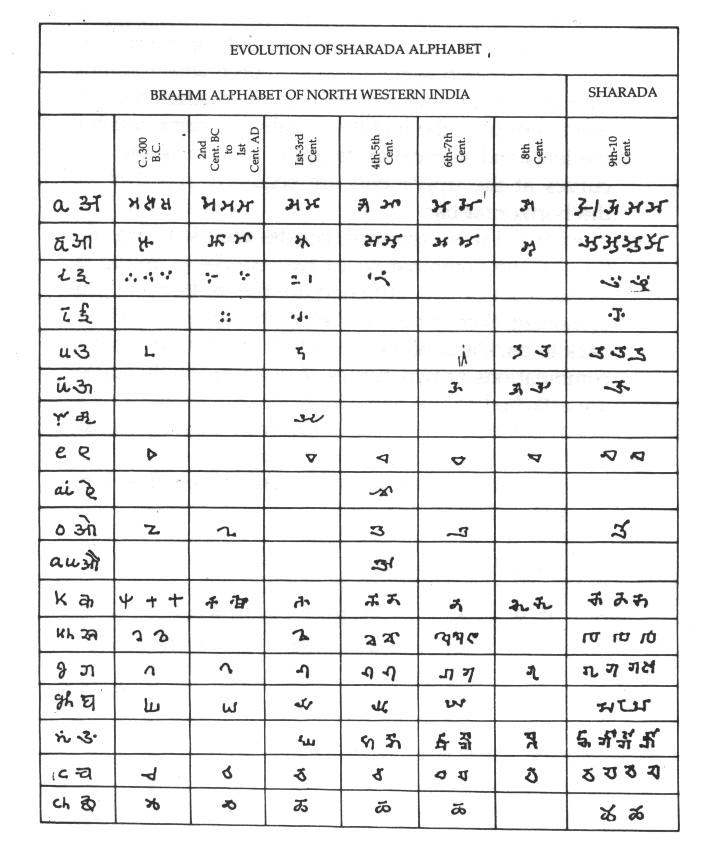
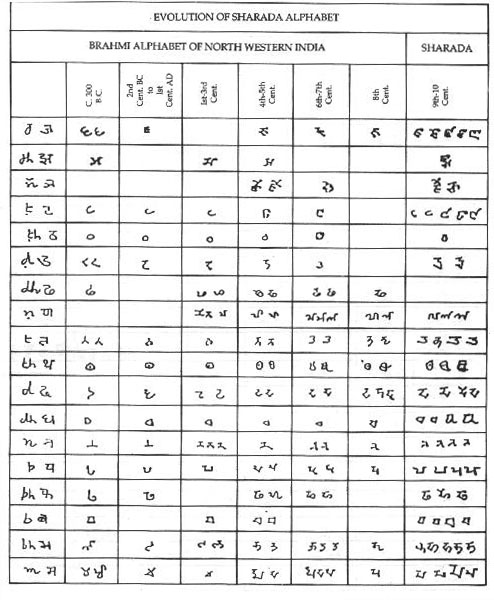
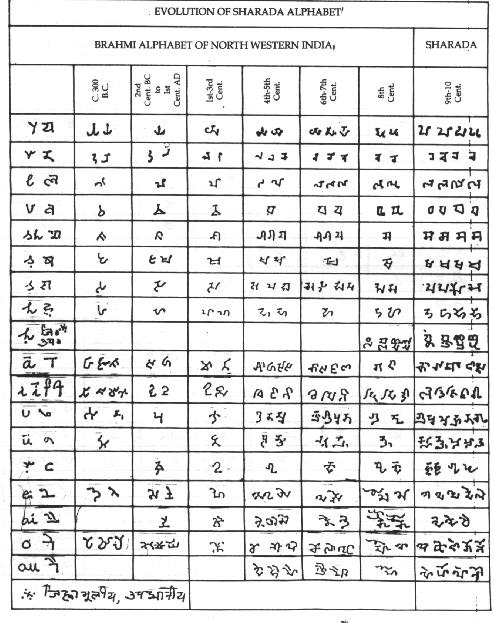
Evolution of Sharada Alphabet
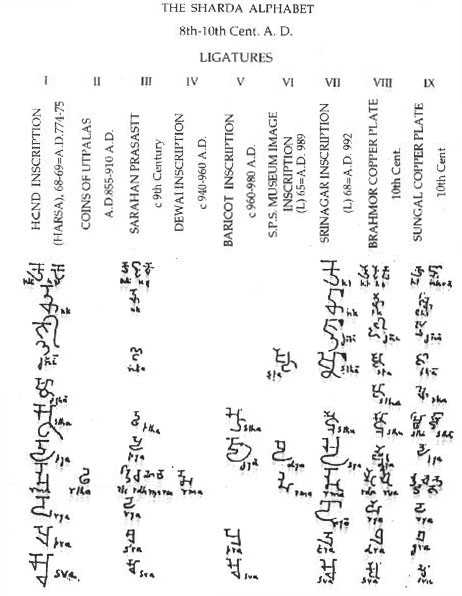
The Sharada Alphabet
8th-10th Century A.D.
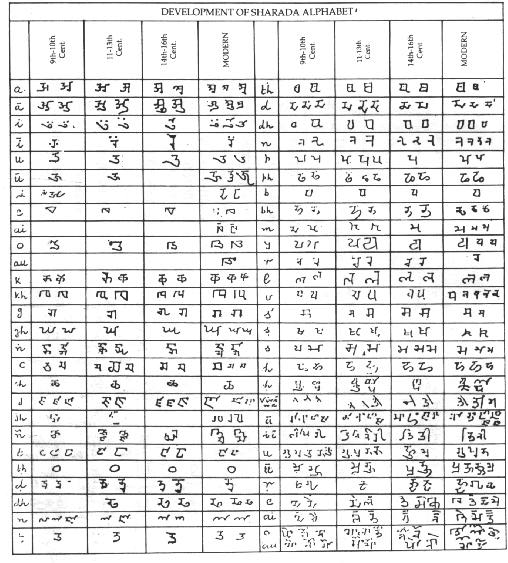
Development of Sharada Alphabet .
|